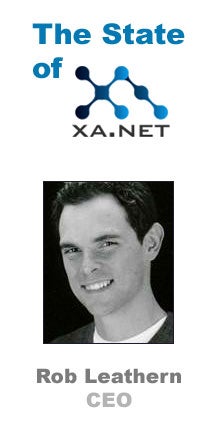 Rob Leathern is CEO of XA.net, an online media buying platform technology and tools company.
Rob Leathern is CEO of XA.net, an online media buying platform technology and tools company.
As part of its “State of…” series of articles with industry executives, AdExchanger.com sat down with Leathern to discuss his company, his views on the space, and the state of XA.net today.
Click below or scroll down for more:
- Facebook Targeting
- The Evolution of XA.net
- On Social Commerce
- Digital Skillsets
- The Creative and Optim.al
- The Milestones Ahead
What is different about the targeting data that’s available through Facebook versus anywhere else?
There are two things that are important. One is that it’s the most robust and largest source of self‑reported demographic data available anywhere in the world. No one else is even half the size of Facebook in terms of the amount of data. You can do demographic targeting on a variety of other large portals, or use data from third‑party vendors, but the quality of the data is low and you’re never going to get more than about 40 percent of the online audience. Whereas with Facebook, they reach 165 million people in the US monthly, and they have age and gender information on 95 percent of them.
The second thing is for brands. Facebook has this ability to target people by affinity: brand affinity, affinity of products, affinity to causes and more. The more that companies are spending time creating and driving customers to “like” them, the more targeting data is becoming available on this platform.
Hopefully, in the future, this data will be, targeted by marketers outside of the walls of Facebook in a privacy‑sensitive way since the walls between Facebook and websites have continued getting lower.
Why is it that advertising works on Facebook without first‑party cookies?
The signal that exists in Facebook is strong if you’re smart enough to know how to target users. The reality is that you’re not going to always target every single user you want. Nobody has built a targeting system that is very powerful, and/or generates a lot of money with the one exception of Google.
Google is the only company that has taken user‑supplied data, and has turned it into a meaningfully-sized business. Facebook hasn’t yet either, but everyone believes that they have the potential to do so.
For marketers, Facebook’s quality of data and the value of their data for targeting purposes are continuously increasing. Every dollar that is spent by a brand to drive fans towards their brand is also continuing to grow the power of this platform from a targeting perspective. It’s what you might call the ultimate network business.
Can you talk a little about the evolution of your business? I used to think of XA.net as a self‑service DSP. It feels like you’ve pivoted into the social space.
I don’t think we’ve pivoted at all. Our goal starting the company was always to be in a place where we could have the biggest impact helping marketers run advertising campaigns – systematically, profitably and with less pain. Any platform where many users are likely to pay attention to an advertising message is somewhere we want to be integrated. Facebook has fit that criteria, LinkedIn is one that we’re participating in right. At some point, perhaps Twitter will be in that category. But we’re interested in scale and the ability to tap into a platform systematically.
What I think has changed for us is that we have recognized the social data component. The understanding of that data is going to be an important part of creating value for marketers going forward. We have devoted additional resources in order to get much deeper on the social side than anyone who superficially puts out a press release announcing, “Oh, we’re a DSP and now you can buy social through us.”
We’ve focused our technology development efforts on the social side, not just as a workflow product to help you buy ads more efficiently, but also to understand the audiences that you have and the audiences that you could have. I wouldn’t say it was a pivot. It’s more of a continued concentration of focus in an area that we think is going to be key to unlocking value for marketers.
Speaking about those marketers, who is the ideal client for XA.net today?
We’re working with marketers directly and through their agencies. In some cases, agencies and the marketers themselves are both involved. In other cases, it’s just through the agencies as a service provider to them.
A good example of a very sophisticated company that we’re working with is One Kings Lane. They don’t necessarily have a deep agency relationship so we’re working with them directly.
Also, we’re not in the business of working with small businesses. We have some channel partners that we work with but most of our customers are large or mid‑size enterprises or agencies. Our minimums for display and/or for Facebook are $10,000 a month.
Any thoughts about how commerce is going to change because of social media?
Companies are going to find it useful to tie user purchasing behavior or recommendation behavior more closely into the existing social networks that exist out there. We work with a lot of companies who are trying to understand things like influential customers. Are the influential customers the same ones who are spending the most with them? It’s usually not the case. You may have an influential customer who can spread the word about your product or service that isn’t necessarily the biggest spender on your product or service.
The big trends are going to be tapping into influence and creating viral offers that are spreadable.
The other trend will be companies tapping into existing databases of their most valuable customers and getting them to advocate on their behalf within these social networks. Companies are going to get these users to encourage other users to become fans, to make purchases or to learn more about new products.
There’s this new opportunity for existing, valuable customers to be the voice of the brand which will increase with more social media opportunities and integration.
With XA.net, the overall idea is to provide a media‑buying platform that spans both the social‑‑when I say, social, I mean Facebook, Twitter and LinkedIn ‑‑and also the Google world, the search world, right? It would seem, from a marketer’s perspective, that they really need one platform to control both. Do you agree with that?
Yes. I think where we come down on it is that the search business is one that’s been around for a while and there are a lot of solutions out there already. We think that a targeting optimization problem is a much more difficult one and a much more diffused one. Our goal is to have a platform that helps marketers across that spectrum which includes what people traditionally today think of as display or social display.. We see ourselves as having a role to play when there is an existing relationship between the company and the customer.
In the past, with search for the most part, there was no pre-existing relationship available when someone goes to a search engine and searches for a company. We’re going to be in the business of both acquisition as well as retention, and helping companies understand the value and tradeoffs between how they communicate with customers through these various online channels. But search is not currently a part of what we think our customers are typically looking for.
There are a bunch of search marketing companies that have created display platforms or social platforms. What we hear almost universally from customers that we talk to is how, in many cases, the only reasons they use those add‑ons is because they’re paying next to nothing for them. The problem is they’re missing a lot of opportunities because they’re getting very little actual value out of those platforms. We think most marketers are smart enough to go to the best‑of‑breed. We have no interest in being a search provider, but we believe that,on the social and display side, we are a best‑of‑breed provider and can help them out.
What do you think is the biggest gap right now in terms of skill set in digital? Sales? Marketing? Engineers?
First, people with the best and most transformative technology, and the people with the loudest and most effective sales voices are not usually in the same company. I think the inefficiency is in a lot of good salespeople who sell inferior products, and a lot of good technology companies do not yet have the similar salespeople to sell their products. That’s one of the things out there; it’s just a reality. It’s hard to find great talent right now even tough there are a lot of people in the market.
On the sales side, there’s an acute need for expanding the base of salespeople who can help translate some of the amazing innovation that’s happening week‑by‑week into the hands of customers. Part of the problem is that it’s hard for customers to understand, because things are changing so quickly. I see that as the biggest area that the industry needs to work on: we need to align the messaging, capabilities and the customers’ understanding of all of the above into a single package.
You have a product called optim.al which focuses on the development of ad creative. A lot of creative people out there are concerned that automation has taken money out of their pockets. What are you seeing about that creative role and how it’s evolving in social?
If it appears like some doors are closing on the creative side, it’s out-weighed by others opening. In certain systematic systems we are working with,companies that have their creative partners login to our own optim.al tool and submit the creative. Some of the creative thinking may be different in that now they think about adding and creating a group of elements that work together. These new tools help creative people figure out new ways of interaction with the consumer. The best thing in our system is the real-time aspect. Within 10 seconds of an ad being turned on, they can receive feedback – it’s potentially a different world than creating a magazine ad, and having it run a month later without actually knowing what the reaction was among consumers. For creatives, there’s this opportunity to engage very meaningfully, and then get almost instant feedback from those creative ideas.
We’re never going to be in a situation where we don’t need creative minds to come up with things that are going to grab people’s attention. The targeting and the matching of the creative to the targeting – all of that stuff can be made more systematic through systems like ours. But the inputs are always going to need to be creative, and you’re always going to need people to think “outside the box” to come up with those components.
Looking into XA.net’s future, what are some milestones that you want your company to achieve?
We want to be seen as the go‑to authority for social and data‑driven media buying.
The other thing I would say is that so far we have been a company focused on building technology. We’ve done pretty well in terms of, given our size, getting into the marketplace and having top‑notch customers. The next two years for us is about building a sales and marketing presence, and getting our name out there. That will be our focus for a while. You’ll start to see more announcements around that.
Follow Rob Leathern (@robleathern), XA.net (@xa_net) and AdExchanger.com (@adexchanger) on Twitter.
By John Ebbert












